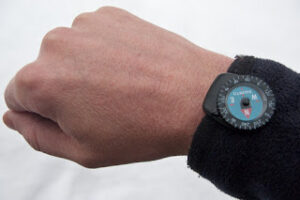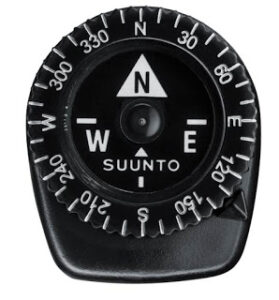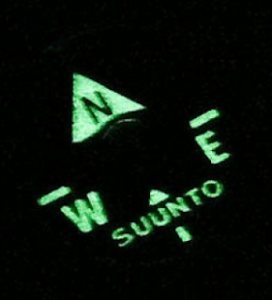The engineer’s compass is my oldest compass, but the compass that I have used the most is my Suunto clipper. At first glance you may mistake this for a simple button compass of the sort so often found in survival kits. Look more closely and there are two distinctive features.


The first feature, and what gives it its name, is the Suunto clipper has a clip. This can be clipped onto your watch strap but I have in the past attached it to lapels or cuffs, as needed. It is a well-designed clip which will securely grip a strap or material of sufficient thickness.
The other feature is that this diminutive compass has a moving bezel. The bezel is marked in 10 degree increments, with letters at the four cardinal directions and numerals every 30 degrees in-between. The bezel rotates with audible “clicks”. Interestingly, there are four clicks to every 30 degree arc. For example, between N and 30 degrees there is a click at N, 10, 15, 20 and 30 degrees. You can therefore set the bezel exactly to bearings such as 15° or 45°. A very intelligent feature and some very nice attention to detail by Suunto.
To the outside of the bezel is a small triangular pointer. Move the bezel so that the pointer is on your desired bearing. Align the needle with “N” on the bezel and select a landmark in the direction the pointer indicates. A quick stroke of model paint makes this pointer even more distinctive.

I’ve had my clipper many decades now. It is a model with a blue card. Some websites claim the letters on the card are luminous. Either this has worn off on my own example or it was a feature that was introduced on later models. The more modern examples have a black card. Some websites also list the clipper as being suitable for diving!

One reason that I have used the clipper so often is that it is the compass that I always have with me. I have a small container, rather like a 35mm film container but oval in section. The clipper lives in this at the bottom of a belt pouch, sometimes sharing its accommodation with a couple of aspirin.
If I am out in the wilds I will pack a larger compass. The clipper has proved most useful in environments where the need for a compass is often unanticipated. Many guidebooks will give you directions such as “the hostel can be found a few blocks northeast of the station”. There are a number of techniques that can be uses to determine direction in an urban environment but sometimes these cannot be used. The sky may be overcast or satellite dishes are not visible. This is when a compass like the clipper comes in very useful.